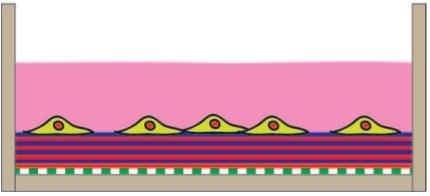Improving Cell Fate Yield and Reliability
In today’s tissue engineering market, common research methods use Petri dishes when working with cells. In using the Petri dishes, difficulties arise in an experiment when scaling-up, in quality assurance, and in quality control. For research outside of the body- in vitro- it is important to have the ability to control cell fates by driving proliferation, maintaining pluripotentcy, and more.
To generate consistent results that produce the cells intended, a new coating technology at Worcester Polytechnic Institute has been developed. With the newly developed coating, there is now the ability to direct cell fates in vitro. Additionally, this technology is removable and, therefore, it is possible to recycle cell culture dishes. A layout of the cell coating is show in the figure below:
Unique to this invention, the coating can be tailored in terms of the assembly conditions to the chemical, physical, and biochemical needs of the cells to be cultured. With this versatile adaptability, the yield and reliability of cultured cells produced will increase and benefit individuals working with a small or large amount of cultured cells. In result, the coating will speed up and simplify the cell culture process while removing the human error that comes from culturing the cells by hand. First of its type on the market, this coating has the potential to enhance the tissue engineering market significantly. One application can be for in the therapeutic market, but the options only expand from there.

Key Features/Benefits
- Tissue engineering coating that generates consistent cultured cells
- Tailored to the chemical, physical, and biochemical needs of the cells being cultured
- Improves and increases yields of desired cell types
- Can be used for large or small scale cell cultures
- Scalable and reliable -Takes out the human error aspect of culturing the cells -Removable coating